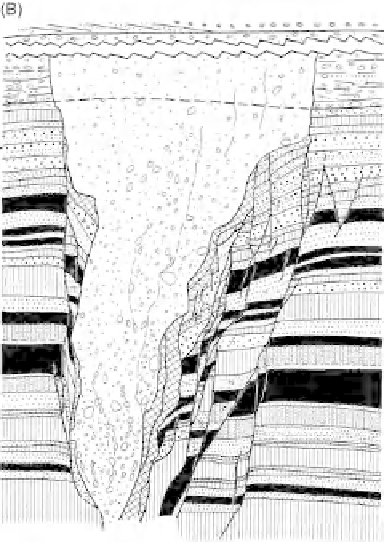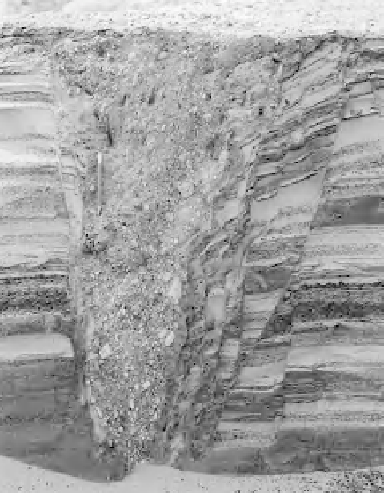Geology Reference
In-Depth Information
Because Pleistocene frost fi ssures are important in terms of their paleo-environmental
signifi cance, each type is briefl y discussed.
Ice-wedge pseudomorphs (Figure 12.1) are structures of secondary fi ll. They form when
the ice wedge slowly melts, usually as the permafrost degrades but sometimes by running
water and thaw erosion acting preferentially along the wedge (see Chapter 8). As the ice
melts, sediment collapses into the void. In arctic regions today, a range of processes are
involved, including thermal erosion, collapse, subsidence, refreezing, loading, buoyancy,
spreading, folding, and shearing (Murton and French, 1993b). A sketch of an immature
pseudomorph forming above a partially-thawed ice wedge is illustrated in Figure 8.6. The
bent, u-shaped involution (60-70 cm deep and
20 cm wide) above the ice wedge is char-
acteristic of the thaw-transformation stage (Harry and Gozdzik, 1988). A fully developed
pseudomorph (Figure 12.2) is characterized by the penetration of material into the fi ssure
from above and from the sides, the downward infl ection of layers if the enclosing sedi-
ments are stratifi ed, and various systems of miniature faults.
Sand-wedge casts contain a fi ll of relatively well-sorted eolian fi ne sand that is quite
different from the enclosing sediment. They often possess a more truly wedged shape with
a relatively clear boundary between the wedge and enclosing material. This is because
≤
(A)
Figure 12.2.
Saalian-age ice-wedge pseudomorph with well-developed en echelon downthrows
exposed in the Dilitzsch-SW brown coal (lignite) mine near Lissa, eastern Germany. (A) Photo-
graph; (B) sketch. Pencil in A is 15 cm long. Photograph, sketch, and caption information are sup-
plied courtesy of Professor L. Eissmann.


